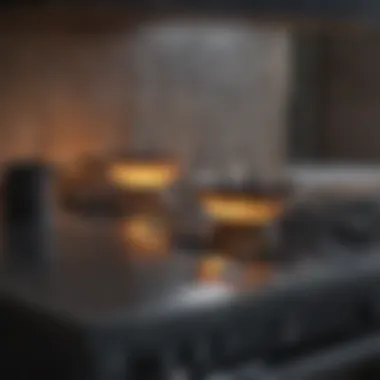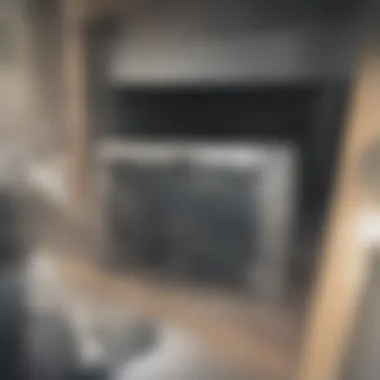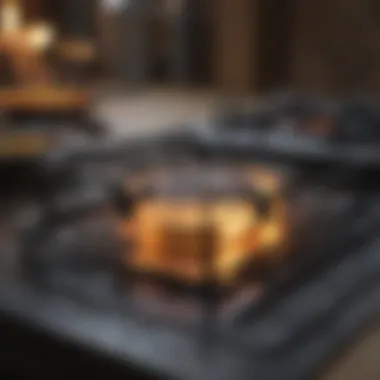Comprehensive Guide to Cleaning Glass Top Stoves


Intro
Cleaning a glass top stove may seem straightforward, yet it involves several nuances that can greatly affect its performance and appearance. This guide delves into the intricacies of effectively maintaining glass top stoves.
Proper cleaning methods not only enhance the visual appeal of these cooking surfaces but also optimize their lifespan. Glass top stoves are a popular choice for many homeowners due to their sleek design and efficient heat distribution. However, they require specific care and attention. The following sections will provide detailed insights and practical tips on maintaining your glass stove, preventing stubborn stains, and employing the right cleaning agents to achieve the best results.
Effective Cleaning Agents
Choosing the right cleaning agents is crucial to prevent damage to the glass surface. Common options include:
- Baking Soda: A gentle abrasive that helps lift grime.
- Vinegar: Acts as a natural disinfectant and cuts through grease.
- Dish Soap: Ideal for everyday cleaning and maintenance.
To ensure effectiveness, mix these agents according to guidelines. For example, a mixture of baking soda and water can create a paste that works well on tough stains.
Techniques To Prevent Tough Stains
Prevention is key when it comes to maintaining a glass top stove. Here are some strategies to minimize stains:
- Use Flat-Bottomed Cookware: This helps distribute heat evenly and reduces spills.
- Clean Spills Immediately: Tackling spills right after they occur prevents them from becoming stubborn stains.
- Regular Wipe-Downs: After each use, a quick wipe can deter the buildup of grease.
"Regular maintenance not only preserves stovetop aesthetics, but also enhances safety while cooking."
Removing Tough Stains
In case of tougher stains, consider the following steps:
- Let the Stove Cool: Always wait for the surface to cool down before cleaning.
- Apply the Cleaning Paste: Use a mixture of baking soda and water directly on the stain.
- Use a Scraper: Gently scrape the area with a plastic scraper to avoid scratches.
- Wipe Clean: Follow up with a cloth dampened in vinegar for a streak-free finish.
Maintenance Tips for Longevity
Maintaining a glass top stove requires attention to detail. Here are some practical maintenance tips:
- Never use abrasive cleaners or scouring pads. These can scratch the surface and diminish its shine.
- Keep the stove dry. Excess moisture can lead to water spots.
- Schedule Regular Deep Cleanings. At least once a month, conduct thorough cleaning to maintain the glass's clarity.
The End
Prelims to Glass Top Stoves
Glass top stoves have gained popularity in many modern kitchens. Their sleek design and smooth surface can enhance the aesthetics of any cooking space. These stoves offer functionalities that appeal to both amateur and professional chefs. Understanding how to clean and maintain glass top stoves is essential for preserving their appearance and performance.
One of the significant advantages of glass top stoves is their ease of use. They typically heat up quickly and offer precise temperature control, making cooking more efficient. Moreover, their flat surface provides an even cooking experience, which many users find desirable.
However, it is important to consider the nature of the material. Glass top stoves can be more vulnerable to scratches and stains compared to traditional stovetops made of metal. Therefore, a proper cleaning routine is critical. Any neglect in maintenance can lead to both aesthetic issues and functional problems over time.
In addition, understanding the specific requirements for cleaning these surfaces ensures that they remain in excellent condition. Different cleaning agents can have varying effects on the glass, making it crucial to choose the right products and methods.
Practicing efficient maintenance not only extends the stove's service life but also contributes to overall kitchen hygiene. As we explore the various aspects of cleaning glass top stoves, we will cover essential cleaning supplies, procedures, and preventative strategies that can significantly enhance both functionality and design appeal.
"Regular maintenance of your glass top stove can prevent long-term wear and preserve its aesthetic appeal."
Understanding the Material
Understanding the materials used in glass top stoves is crucial for proper maintenance and cleaning. Glass top stoves are not only functional but also serve as a focal point in many kitchens. The material, typically tempered glass, is designed to withstand high temperatures while providing an aesthetic appeal. However, its surface can be susceptible to scratches and stains if not cared for correctly. Knowing the characteristics of the material allows users to choose the right cleaning methods and products, thus prolonging the lifespan and appearance of their stoves.
Safety and Durability
When it comes to safety and durability, tempered glass remains a popular choice for stovetops. This type of glass is made to endure sudden heat changes, which minimizes the risk of cracking or shattering. However, users should still exercise caution. Avoid dropping heavy objects on the surface and refrain from using cookware with rough bottoms that can scratch the glass. Proper safety measures can mitigate potential risks while maintaining durability over time.
- Do not use abrasive materials: They can damage the glass.
- Always let the stove cool before cleaning: This prevents thermal stress on the glass.
- Use cookware that is compatible: Check for smooth and sturdy options that secure against the glass.
Keeping these safety tips in mind can enhance the durability of the surface and maintain its original quality.


Common Issues Faced
Despite the benefits of glass top stoves, users often encounter several common issues. One prevalent problem is the formation of burnt-on residue after cooking. This residue can create a less appealing surface and may affect the cookware’s interaction with the elements below. Furthermore, chips or scratches can occur due to improper handling or abrasive cleaning methods.
Users may also face difficulties with specific types of stains.:
- Water spots: They can appear from boiled water.
- Cooking spills: These can burn onto the surface quickly if not cleaned promptly.
- Discoloration: This may happen from prolonged exposure to excessive heat.
Addressing these issues requires a nuanced understanding of the material to select appropriate cleaning techniques. Understanding these common challenges prepares users to confront them effectively, ensuring that their glass stovetops remain in peak condition.
Essential Cleaning Supplies
The journey of maintaining glass top stoves begins with understanding the essential cleaning supplies. These items play a pivotal role in ensuring the stove remains functional and visually appealing. Having the right tools and materials not only makes the cleaning process easier but also enhances the effectiveness of the methods employed. It is crucial to differentiate between various products and their specific uses to avoid damaging the glass surface.
Benefits of Quality Cleaning Supplies:
Using recommended cleaning agents contributes to preserving the glass surface’s integrity. Quality cleaners help in breaking down grime and stains without scratching or etching the surface. Moreover, the right tools can prevent the build-up of dirt and reduce the frequency of deep cleaning.
When it comes to cleaning supplies, consideration must also be given to environmental impact. Many manufacturers offer eco-friendly products that provide adequate cleaning power without harmful chemicals. This aspect is especially important for households with children or pets.
Considerations When Choosing Supplies:
- Chemical Composition: Ensure the cleaner is suitable for glass and will not cause harm.
- Ease of Use: Select products that facilitate quick and efficient cleaning.
- Compatibility with Cookware: Opt for options that are safe to use alongside various cookware materials, minimizing risk of reaction.
"Choosing the right cleaning supplies is a fundamental part of maintaining glass top stoves effectively."
Recommended Cleaners
When it comes to cleaning glass top stoves, various products can yield excellent results. The following are some recommended cleaners:
- Cerama Bryte Cooktop Cleaner: Known for its effectiveness in removing tough stains and burnt-on food, this cream cleaner is widely regarded.
- Bar Keepers Friend: This powder can restore shine and remove stains without scratching surfaces.
- Weiman Cooktop Cleaner: A liquid cleaner that is ideal for daily maintenance, keeping the surface shiny and clean.
Each of these products is formulated specifically for glass stoves, making them safe options that enhance cleaning efficacy.
It is advisable to follow the manufacturer's instructions for best results.
Avoidable Products
Not all cleaning products are suitable for glass top stoves. Some should be avoided to prevent damage, as using these can lead to scratches and deterioration. Here is a brief list:
- Abrasive Cleaners: Products that contain gritty particles can easily scratch the surface of the glass.
- Powdered Cleaners: If not specifically designed for glass, they may also cause scratches.
- Bleach or Ammonia: These sever chemicals can break down sealants and harm surfaces, diminishing the stove's longevity.
In summary, selecting the right supplies is vital for the maintenance of glass top stoves. Taking the time to choose recommended cleaners while avoiding harmful products ensures one can keep their stove clean and in optimal condition.
Step-by-Step Cleaning Guide
Cleaning a glass top stove requires a methodical approach. This guide provides practical steps that not only aim to enhance the visual appeal of the surface but also maintain its performance. A systematic cleaning process ensures that every corner of the stove receives attention, which prevents buildup that can cause damage over time. Understanding each step is crucial for anyone interested in preserving their appliance.
Preparation of the Stove
Before starting the cleaning process, it is vital to prepare the stove properly. This preparation includes ensuring the stove is cool to avoid burns and is free from any leftover food or debris.
- Turn Off the Stove: Always ensure that the cooking surface is completely cool. This not only protects against burns but also prevents the cleaning materials from reacting with heat.
- Clear the Surface: Remove all items, including pots, pans, and any debris that might be present. It is easier to clean effectively when you have a clear workspace.
- Inspect for Damage: Check for any visible scratches or damages. Knowing what to look for helps manage expectations regarding cleaning results.
Taking these steps can greatly impact how effective the cleaning process becomes.
Applying the Cleaner
Choosing the right cleaner is as important as the application method. After preparation, you need to apply the cleaner appropriately for optimal results.
- Select the Cleaner: Use a cleaner specifically designed for glass top stoves. Regular household cleaners may be too harsh and could cause damage.
- Dampen the Surface: Use a soft cloth to slightly dampen the cooking surface with water. This helps the cleaner to spread more easily.
- Apply the Product: Follow the manufacturer's instructions for application. A common method is to spray the cleaner directly on the stove surface or onto the cloth before application. Ensure that you cover all areas evenly.
Application is a key step that sets the stage for effective cleaning.
Wiping Techniques


The technique used during the wiping process significantly influences the cleanliness of the stove. Gentle, yet firm motions should be utilized.
- Use a Soft Cloth: Always rely on microfiber cloths or soft sponges. Abrasive materials can scratch glass surfaces.
- Circular Motions: Wipe in a circular motion for even coverage while tackling sticky spots more thoroughly. Make sure to cover the entire surface without applying excessive pressure that can lead to scratches.
- Rinse and Repeat: If needed, dampen the cloth with clean water and go over the surface once more to remove any residue from the cleaner.
Effective wiping techniques can prevent streaks and maintain the shine of the glass surface.
Dealing with Stubborn Stains
Stubborn stains require additional measures and specific techniques to remove them without harming the surface. Knowing how to handle these marks can save time and effort.
- Identify the Stain Type: Different stains may require different treatments. For example, burnt-on food may need a more intensive cleaning approach.
- Use a Scraper: For very stubborn residues, employ a glass scraper at a low angle. This should be done with care to avoid scratches.
- Soak the Stain: Applying a damp cloth or sponge with the cleaner over the stain for a few minutes can help in loosening it before scraping.
Handling stubborn stains requires patience and care, ensuring that your glass top stove remains scratch-free.
The effectiveness of cleaning glass top stoves heavily relies on proper technique and materials. Always follow best practices for a clean and aesthetically pleasing cooking surface.
Ultimately, these steps provide a comprehensive approach to cleaning your glass top stove effectively.
Preventative Maintenance Strategies
Preventative maintenance strategies are critical for maintaining the functionality and appearance of glass top stoves. Implementing these practices can prolong the life of the stove, reduce the frequency of deep cleaning sessions, and ultimately save costs associated with repairs or replacements. With careful attention and routine practices, homeowners can keep their stoves looking new while ensuring they function effectively.
Regular Cleaning Schedule
A regular cleaning schedule is essential for preventing build-up of grease, spills, and stains on glass top surfaces. Setting aside time weekly to clean the stove can help in keeping it in pristine condition.
- Daily Wipe Down: After cooking, it is important to wipe the surface with a damp cloth. This quick maintenance step helps in removing spills before they harden.
- Weekly Clean: A thorough cleaning with appropriate cleaner should be done weekly. This includes using recommended cleaning agents that can break down tougher residues.
- Monthly Deep Clean: At least once a month, a deep clean should be conducted. This involves removing any detachable parts if applicable and ensuring all areas are cleaned adequately.
Establishing this routine will help minimize stubborn stains and maintain the aesthetic appeal of the stove.
Protection Against Scratches
Protecting the glass top from scratches is a vital aspect of preventative maintenance. Since glass tops can be vulnerable to scratching, following some basic practices can help retain their finish.
- Use Appropriate Cookware: Always use cookware that is suitable for glass stoves. Cookware with rough or warped surfaces can scratch the glass. Opt for flat-bottomed pots and pans, preferably made of materials like stainless steel or ceramic.
- Avoid Dragging Cookware: Lifting pots and pans instead of dragging them across the surface can prevent scratches from forming.
- Immediate Clean-Up: Promptly clean up any spills or residues that could harden. This can also help avoid scratching during subsequent cleanings.
By adhering to these protection methods, you will significantly reduce the risk of scratches, keeping your glass top stove looking new for a longer period.
"Regular maintenance not only extends the lifespan of your stove but also keeps it functioning at peak performance."
In summary, implementing preventative maintenance strategies for glass top stoves leads to enhanced longevity and performance. A consistent cleaning schedule and scratch protection measures can greatly contribute to maintaining the stove’s appearance and functionality.
Troubleshooting Common Problems
Cleaning glass top stoves can be an art, but sometimes problems arise that require troubleshooting. Understanding common issues related to glass top stoves is critical for maintaining their appearance and functionality. This section aims to equip readers with the knowledge necessary to identify and resolve these issues. In doing so, homeowners can ensure that their stoves not only look good but also function at their best. Recognizing problems early can prevent more significant damage and extend the life of the appliance.
Resolving Cracks and Chips
Cracks and chips on a glass top stove can be alarming. They pose not only aesthetic concerns but also safety risks. If left untreated, they may lead to more severe breakage, potentially rendering the appliance unusable. To address these issues, start by assessing the extent of the damage.
- Minor chips and cracks can sometimes be repaired with specific glass repair kits. These kits usually contain a resin that can fill the gaps, restoring some integrity.
- For more significant damage, especially long cracks, it is wise to consider replacing the entire glass top. Attempting to use the stove with major fractures can result in accidents or injuries.
It is crucial to regularly inspect your stove for these issues. Early detection allows for easier and more cost-effective repairs. If a chip or crack occurs, avoid using excessive force or pressure on that area until resolved.
Identifying Burn Marks
Burn marks can be another frustrating problem for owners of glass top stoves. They often result from heating spills or foods that burn onto the surface. Knowing how to identify and effectively clean these marks is essential for preserving the stove's surface.
- Look closely at the surface. Burn marks may appear brown or black, making them different from general grime or residue.
- Time is of the essence when it comes to removing burn marks. The longer they stay on the surface, the harder they are to remove. Using gentle scrubbing methods immediately will yield better results.
To effectively remove burn marks:


- Use a non-abrasive cleaner. Products like baking soda combined with water can work wonders. Apply the mixture, let it sit for a few minutes, and then gently scrub.
- Avoid harsh chemicals or scrubbing pads that can scratch the glass.
"Early detection and prompt action are key in maintaining the beauty and functionality of glass top stoves."
Eco-Friendly Cleaning Alternatives
In today's world, many individuals are seeking ways to reduce their environmental impact. Eco-friendly cleaning alternatives for glass top stoves present an excellent opportunity to achieve this goal without compromising on effectiveness. These alternatives not only protect the environment, but they can also enhance safety in the kitchen, especially for families with children or pets. Utilizing natural ingredients to clean surfaces minimizes exposure to harsh chemicals, which are common in commercial cleaners. This section will explore two well-known eco-friendly options: vinegar with baking soda, and various natural oils.
Vinegar and Baking Soda
Vinegar and baking soda are two powerful natural cleaning agents that can provide a deep clean for glass top stoves. Their effectiveness is rooted in their chemical properties. Vinegar, an acetic acid, has the ability to cut through grease and eliminate bacteria. Baking soda, a mild abrasive, helps to scrub away tough stains without scratching the surface.
To use this combination:
- Begin by sprinkling baking soda over the stained area of the stove.
- Then, spray white vinegar over the baking soda. You will notice a fizzing reaction, which indicates that the two ingredients are working together to break down built-up grime.
- Allow the mixture to sit for about 10-15 minutes.
- Wipe the area clean with a soft cloth or sponge.
- Rinse with water to ensure all residue is removed.
This method is not just efficient in terms of performance; it is also very economical. Both vinegar and baking soda are inexpensive and widely available, making them accessible for regular cleaning routines.
Natural Oils
Natural oils can serve as an effective alternative for maintaining the shine of a glass top stove. Oils such as olive oil and coconut oil can provide a protective barrier that repels dirt and grime. Moreover, they add a luster to the surface, which contributes to visual appeal.
To use oils effectively:
- Clean the stove surface first, ensuring no major stains are present.
- Apply a small amount of natural oil onto a clean microfiber cloth.
- Gently rub the oil into the glass surface in a circular motion.
- For best results, use just a few drops, as too much oil can make the surface greasy.
Natural oils not only enhance the look of the stove but also help in preventing future stains. It's advisable to limit the frequency of this method to once a month to avoid a build-up of oil.
Eco-friendly alternatives like vinegar, baking soda, and natural oils help maintain your glass top stove’s functionality while being gentle on the planet.
Expert Tips for Extended Longevity
Ensuring your glass top stove remains in excellent condition requires more than just a cleaning routine. It's essential to adopt practices that support both the durability of the material and its appearance. These tips are aimed at extending the longevity of your investment. They provide insight into minimizing wear and tear, maintaining aesthetic appeal, and preventing common issues often seen with glass top stoves.
Choosing the Right Cookware
The type of cookware used on a glass top stove can greatly affect its longevity. Using heavy pots or pans can lead to scratches and cracks, which are difficult to repair. Opt for cookware that is specifically designed for glass top stoves.
- Flat Bottoms: Select pots and pans with flat bottoms. This helps to ensure proper contact with the stove surface, leading to more even cooking while reducing pressure concentration.
- Material: Stainless steel, enameled cast iron, and copper are generally safe options. Avoid using rough-bottomed or cast iron cookware, as they may scratch the surface.
- Weight: Lighter cookware is less likely to cause damage. Ensure that the weight is manageable to prevent mishaps while cooking.
Following these guidelines will help maintain the smooth surface of your stove while also promoting safety during meal preparation.
Safe Cooking Practices
To achieve extended longevity for your glass top stove, implement safe cooking practices that prevent damage during regular use.
- Avoid Dragging: Never drag pots or pans across the surface. Always lift them to avoid creating scratches.
- Heat Levels: Start with lower heat settings. Glass tops should not be subjected to extreme heat changes, which can cause cracking.
- Use Protective Liners: Consider using stove mats or liners that can act as a barrier. They absorb spills and protect the stove from direct contact with hot cookware.
Adhering to these practices will keep your stove looking new for significantly longer, enhancing not just its appearance but also your cooking experience.
"A little care today can prevent costly repairs tomorrow. Choosing the right tools is a foundation for maintaining your appliance's integrity."
By following these expert tips, you can ensure that your glass top stove remains a visual and functional centerpiece in your kitchen for years to come.
End
Cleaning glass top stoves is more than just a mundane task; it is crucial for both functionality and appearance. This article has outlined various methods and suggestions that can make the cleaning process efficient and effective.
One key element to remember is the importance of regular maintenance. By establishing a consistent cleaning schedule, homeowners can minimize the buildup of dirt and grease. This proactive approach not only ensures the stove looks pristine but also improves its functionality by preventing issues like overheating due to residue, which can be detrimental to cooking performance.
Another benefit discussed is the choice of appropriate cleaning products. Using cleaners specifically designed for glass tops, like Cerama Bryte or Weiman, can preserve the delicate surface of the stove. Avoiding harsh chemicals will safeguard against scratches and other damage.
Moreover, troubleshooting techniques explored in this piece focus on dealing with common problems like stubborn stains or minor damages. Addressing these challenges promptly can prolong the life of the stove and maintain its aesthetic appeal.
In summary, proper cleaning and maintenance of glass top stoves enhance their performance, and longevity. Investing in the right supplies and following effective cleaning strategies will not only keep the stoves looking new but also providing a safer, healthier cooking environment.
"A well-maintained stove is essential to the overall kitchen design and functionality."
Consider these practices and knowledge as valuable tools in ensuring your glass top stove remains a reliable asset in your kitchen.







